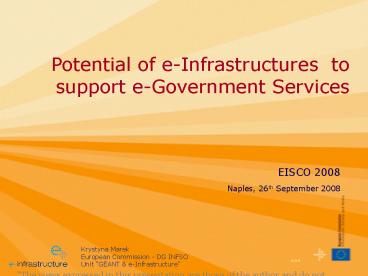1 - PowerPoint PPT Presentation
1 / 22
Title:
1
Description:
... research in which virtual communities share, federate and ... global virtual research communities. Designing future facilities: novel e-Infrastructures ... – PowerPoint PPT presentation
Number of Views:26
Avg rating:3.0/5.0
Title: 1
1
Potential of e-Infrastructures to support
e-Government Services
EISCO 2008 Naples, 26th September 2008
Krystyna Marek European Commission - DG
INFSO Unit GÉANT e-Infrastructure
"The views expressed in this presentation are
those of the author and do not necessarily
reflect the views of the European Commission"
2
Who we are
DG INFSO
Mission "GÉANT e-Infrastructure" supports an
innovative way of conducting scientific research
(referred to as e-Science) by the creation of a
new environment for academic and industrial
research in which virtual communities share,
federate and exploit the collective power of
European scientific facilities.
Unit F3
3
Presentation Outline
Science is changing in similar ways The
challenges ahead governments Who we are and
what we do e-Infrastructures The rationale
behind Network, Grid and Data e-Infrastructures
Towards Global Research Communities Potential of
e-Infrastructures for e-Government Policy
context Examples of running projects
4
Science is changing
- The change is pushed by continuing progress in
computing and ICT
- It is pulled by the expanding complexity, scope
and scale of todays challenges
5
Todays (tomorrows) science
- Information/Data intensive
- Capability and capacity of scientific devices,
storage systems, computers and networks - Using simulation and modelling
- Especially when physical experiments cannot be
easily performed (climatology, astrophysics) - Collaborative and distributed
6
ICT infrastructures for science
Sharing and federating scientific data
Sharing computers, instruments and applications
Linking at the speed of the light
7
e-Infrastructures 5 vectors
8
GÉANT connecting Europe
- High speed computer network reserved for research
and education use - Connects 30 National Research and Education
Networks (NRENs) - Hybrid architecture
- connectivity at 10 Gb/s
- 50 000 km of
- optical fibre links
9
GÉANT global reach
10
EGEE large multi-science grids
- Enabling Grids for E-sciencE (EGEE)
- Provides grid services available
- to scientists 24/7
- Computer power and data storage capacity
- Connects more than 240 sites in 45 countries
- 100 000 jobs are completed per day from different
scientific domains
11
Data as an infrastructure
12
eInfrastructure and government
- Governments responsible for administration,
decision making and policy making, service
delivery - Government is potentially important user of
e-Infrastructures, providing an environment with
specific characteristics - related with democratic governance in
knowledgebased society (privacy and trust) - and others
13
- Information/Data intensive
- Using simulation and modelling
- Collaborative and distributed
14
Cyberinfrastructure and e-Government
- The delivery of government services can also
benefit from the potential of shared computing
and data storage, systematic integration of
disparate data sources, shared and virtual
collaboration across organizational boundaries.
- Cyber-Infrastructure and e-Government The
Perspective of Government CIOs - http//egov.epfl.ch/UserFiles/File/CIO20Symposium
20Program_final.pdf
15
Aho Report 2008
- Information Society Research and Innovation
Delivering results with sustained impact (May
2008) - The interconnection of large regional and
national e-Infrastructures should be further
developed. - EU-wide platforms and infrastructures are needed
in sectors such as e-Government (especially
procurement), e-Health (cross-border
applications), logistics and transport.
16
ERINA study
- Recommendations for Exploiting Research
Infrastructure Potential in Key Areas of the
Information Society - (eGovernment, eHealth and eLearning)
- Study investigated the benefits of using
e-Infrastructures beyond research - analysed whether the use of advanced information
technologies in these areas would stimulate
innovation - confirmed the potential of adopting
e-Infrastructures in key areas of the Information
Society.
17
Connectivity
- Eduroam
- EDUcation ROAMing
- Open your laptop and be online
- The roaming infrastructure used by the
international research and education community
that provides secure Internet access. - While the network access is granted by the
visited institution, the authentication is done
by the home one.
18
Grid computing
- CYCLOPS
- Cyber-Infrastructure for CiviL protection
Operative ProcedureS - Aims at developing enabling e-infrastructures and
virtual organisation services to serve specific
GMES applications. - Improvement in the effectiveness of Civil
Protection coordination and planning.
19
Data repositories
20
Anticipated benefits for government
- Providing new/improved services
- Joining-up research efforts in Europe
- Collaborating with other regions
- Facilitating policy development
- Technical development (improved efficiency of
operations) - Using RD money better!
21
Further information
www.cordis.europa.eu/fp7/ict/e-infrastructure/
krystyna.marek_at_ec.europa.eu
22
Thank you































